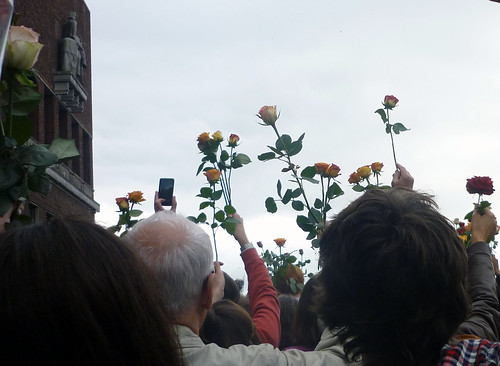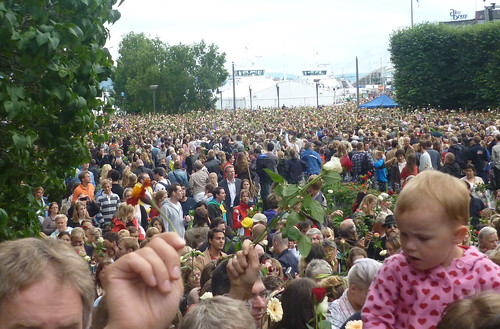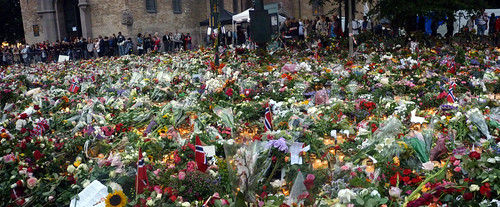
Now it is 5 years since the first terror action on Norwegian soil and it was not committed by a Muslim or a foreigner but one of their own, a Norwegian man, who hated it that Norway accepted refugees and other immigrants. But he did not attack immigrants, he blew up a government building and attacked a youth conference of the labour movement. He wanted to destroy possible future politicians who he thought would also let immigrants into the country. He killed almost 80 on the island. He had wanted to kill all 600, but it was too much even for him.
He used a gun and though he considered suicide when caught, he decided against it as he could further inform people of his extreme right-wing ideas during his court case.
Other countries admired Norwegians for their reaction. Oslo and other population centres arranged marches with torches to the honour of the victims. That proved impossible in Oslo. The streets were so full of people that fire could not be used. We called it a rose march because everyone held roses instead. When I arrived to the city, all roses had been bought so I bought some cloth roses.
The march centered in front of the City Hall where Prime Minister Stoltenberg, Crown Prince Haakon and others spoke. People held up roses, there were other flowers, I could even see sunflowers. People were asked to lift roses aloft to make like a rose garden. Afterwards people lifted them up when they wanted to applaud.
200 000 had gathered round the Town Hall, at the Town Hall Square, spilling on to Aker Brygge, the side streets, even the Akershus Fortress, filling all available space. At one stage people spontaneously started singing the National Anthem of Norway, "Ja, vi elsker dette landet." There was another song, "Til ungdommen" (To our youth), the singer was Herborg Kråkevik, this was very popular.
"We will respond with more openness, more democracy and more humanity, "said Prime Minister Stoltenberg. "If one man can show so much hatred, imagine how much love we all can show together," said a Labor girl who was interviewed by CNN. Prince Haakon talked about "filling the streets with love."
It was also called "The day that people took Norway back."
After the meeting was over, people were told to decorate the city with the roses. They put them on statues, fences, fountain rims, flower pots, steps of the Town Hall, walls, on the square in front of the University on Karl Johan... I walked around for two, three days to photograph them.
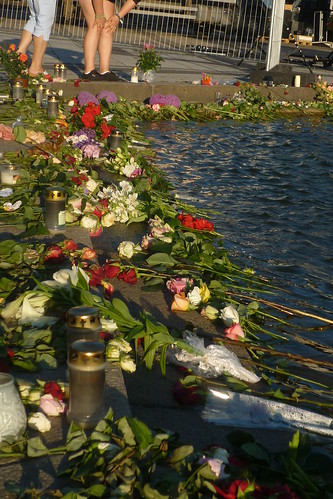
Crown Princess Mette Maarit (she had also lost a relative) with relatives of the killed and other people started putting roses in front of the Cathedral, people followed. People stayed here long into the night, looking at the flowers and the candles. The Cathedral was open so people went in to put candles in the sanctuary (chancel), there was a continuous queue. I went the again after midnight, people were still coming. It got very hot with all the burning candles.
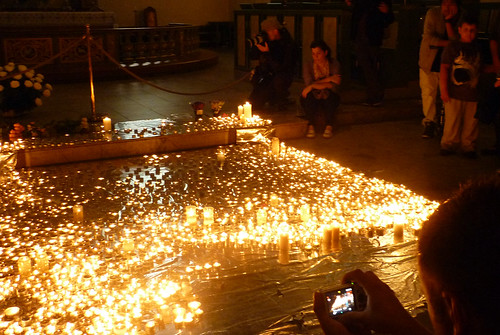
Earlier there were books you could sign in the University Aula.
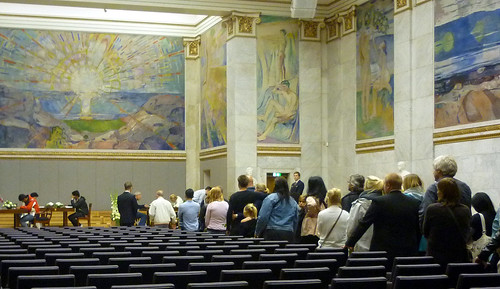
Later there was a memorial service in the Cathedral. Through TV people throughout the world could see King Harald and Queen Sonja weep.
Knut Olav Amas, of The New Yorker, wrote : "Have the political élites and the people ever reacted in such a manner to a terror attack anywhere before? I think the absence of fear and vengeance in Norway today makes it possible to strike a new balance between freedom and security without, I hope, creating new enemies or new conflicts. Of course, it is easier to react in this way when the terrorist is already behind bars, and seems to have operated on his own, than when terror attacks are carried through by a global organization and the mass murderers are still at large."
From 3. August to September 2011 Oslo Commune collected 15 tons of flowers and 5 tons of used candles from around and in front of the church. The State Archive has preserved 4773 greetings that were left with the flowers.
The newspaper VG has interviewed some people.
"We have traveled to Oslo, Aust-Agder and Hordaland. People we met are surprisingly clear: Norway has not taken hold of the important issues by 22 July.
We have neither been a more tolerant or open society. And we have not taken issue with xenophobia.
The head of the Nobel Peace Center, Liv Tørres survived the bomb in the government quarter .
The question many of the survivors really are concerned about is: Can it happen again?
- The most important thing we can do is to recognize that the attack on July 22 was a political attack. And that warning signs are there for the future. Breivik reacted to multiculturalism and Islam. And there are many who share his vision. Why do we behave, as if there is only one Breivik? she asks.
It is confirmed that the network proportionality, extremism and radicalization is worse than ever.
He explains that the right extremist groups are still small, although growing. And that they lack a clear leader figure.
- It's hard to sift out those who pose a danger, from the amount of network roll spreading hate speech. Especially on social media does hate flourish. "
There is a Norwegian net magazine, the name of which I will not write, where all the articles are about alleged atrocities done by Muslims and immigrants. That's what our world is like now
I live east of the city centre, with lots of immigrants and I feel quite safe here and happy to meet people of different cultures. In ALC we come from many lands, too.




